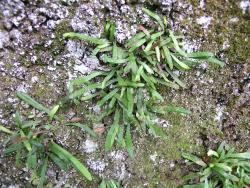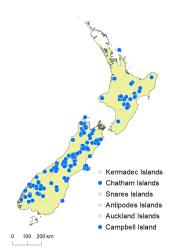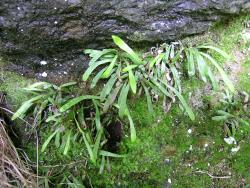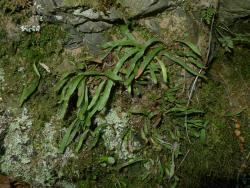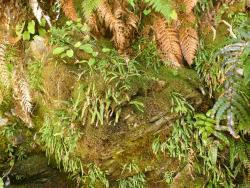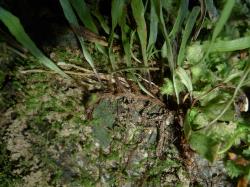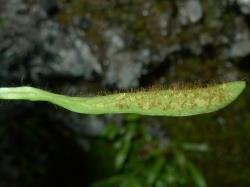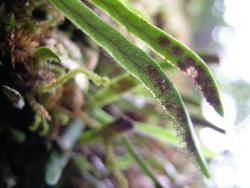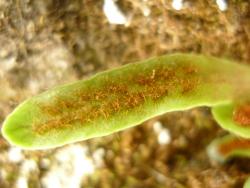- ≡ Polypodium patagonicum C.Chr., Ark. Bot. 10: 15 (1910)
- ≡ Grammitis patagonica (C.Chr.) Parris in Parris & Given, New Zealand J. Bot. 14: 108 (1976)
Rhizomes long-creeping, bearing scales. Rhizome scales ovate to narrowly ovate, 1.1–4.2 mm long, 0.2–1.1 mm wide, pale red-brown, concolorous, non-clathrate. Stipes 1–30 mm long, black, distinct, not winged, hairy. Stipe hairs abundant, dark red-brown, 0.4–3.0 mm long. Fronds undivided, narrowly obovate, 6–160 mm long, 2–10 mm wide; apices acute to obtuse; margins entire; bases attenuate to a distinct stipe; both surfaces pale green; herbaceous to coriaceous; glabrous or bearing sparse to abundant hairs up to 3 mm long on the margin, costa and lamina surface. Hairs either setae, or branched hairs with setiform branches. Hydathodes usually absent or rarely present. Sori subglobose to elliptic, elongated along veins, slightly oblique, 1–4 mm long, in 1–17 pairs in distal half of lamina, bearing abundant red-brown hairs up to 3 mm long. Sporangia 200–400 µm long; spores 30–60 µm diameter.
Notogrammitis patagonica is characterised by its long-creeping rhizomes, distinct stipes, narrowly obovate fronds, and the presence of hairs throughout the frond and in the sori. It is distinguished from N. crassior by its hairy rather than glabrous fronds, and from N. givenii by the presence of hairs on the lamina surfaces and in the sori. It is very similar to N. gunnii but generally has a larger frond (up to 160 mm long, cf. up to 95 mm long) and longer, dark red-brown stipe and soral hairs.
North Island: Auckland, Volcanic Plateau, Gisborne, Taranaki, Southern North Island.
South Island: Western Nelson, Sounds-Nelson, Marlborough, Westland, Canterbury, Otago, Southland, Fiordland.
Chatham Islands, Campbell Island.
Altitudinal range: (10) 250–1635 m.
Notogrammitis patagonica is found only in montane to alpine areas of the North Island from Great Barrier Island, the Raukūmara Ranges and Mt Pirongia south to the Tararua Ranges. It occurs mostly in a zone between 1000 and 1635 m. In the South Island it is more widely distributed in montane and subalpine areas from north-west Nelson to Fiordland and Dunedin, reaching 1450 m in the Arthur Range, north-west Nelson, and descending to 250 m in the Hunters Hills, Canterbury. It is found on the Chatham Islands, where it has been collected at only 10 m (de Lange et al., AK 295983!), and on Campbell Island, but not on the other subantarctic islands.
Also Chile, Argentina (Parris & Given 1976; Perrie & Parris 2012).
Notogrammitis patagonica is found in podocarp and beech forest, subalpine scrub, tussock grassland, and alpine herbfield. It grows on wet cliff and rock faces, in rock crevices, under overhangs, on damp banks and stream banks, and near the base of waterfalls. It favours limestone and marble substrates, but is also found on andesite, basalt, granite, rhyolite, schist, greywacke, mudstone, and sandstone.
A single collection (WELT P027882) has the frond morphology of N. billardierei but the soral hairs of N. patagonica and is likely to be a hybrid between the two species.
n = 37 (Brownlie 1961– as Grammitis ciliata). The count by Brownlie (1961) is now known to relate to Notogrammitis patagonica (see Perrie & Parris 2012, Table 1).



